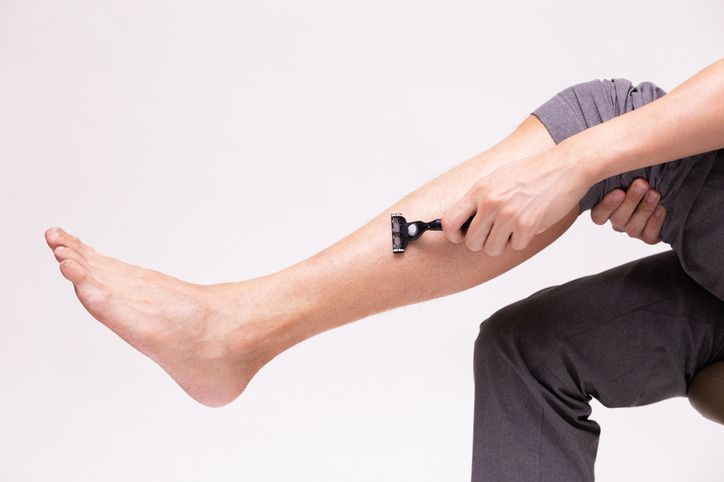
免費體驗
A3 Laser Hair Removal Treatment
1 Minute Self-Registration
Date should not be before minimal date
In today's fast-paced world, personal grooming has taken on a whole new level of importance. With fashion trends evolving rapidly, the desire for smooth, radiant, and well-groomed legs is more significant than ever. Whether you're gearing up for a special event or simply seeking everyday confidence, having gorgeous legs is a game-changer. In this comprehensive guide, we, as experts in the field, will reveal the secrets to achieving flawless legs that not only look stunning but also feel incredible.
1
Women's Leg Hairs: Why Do They Exist?

Women, like men, have leg hair primarily as a result of evolution and biology. The presence of body hair, including leg hair, serves several potential functions:
1. Thermoregulation: Body hair can help regulate body temperature by providing insulation in colder conditions. It traps a layer of warm air close to the skin, helping to keep the body warm.
2. Protection: Body hair, including leg hair, can offer some protection against external factors such as UV radiation, small abrasions, and insect bites.
3. Sensory Function: Hair follicles are connected to nerve endings, and leg hair can play a role in sensory perception. When hair is moved, it can trigger nerve responses that help individuals detect objects or insects on their skin.
The length and thickness of leg hair can vary significantly among individuals, and several factors influence this variation:
1. Genetics: Genetics plays a significant role in determining the thickness and length of leg hair. Some people have genes that predispose them to thicker or longer leg hair, while others have genes for finer and shorter hair.
2. Hormones: Hormones, particularly androgens like testosterone, influence the growth of body hair. Women typically have lower levels of androgens than men, which is why their body hair, including leg hair, tends to be finer and less coarse. However, hormonal changes during puberty and pregnancy, as well as medical conditions like polycystic ovary syndrome (PCOS), can result in increased androgen levels and, consequently, thicker and longer leg hair in some women.
3. Age: As people age, changes in hormone levels can affect hair growth. Some women may notice that their leg hair becomes finer and less prominent as they get older.
4. Medications and Medical Conditions: Certain medications and medical conditions can affect hair growth. For example, some medications can stimulate hair growth, while others can slow it down. Medical conditions like hirsutism can lead to excessive and unwanted hair growth on various parts of the body, including the legs.
5. Personal Grooming Habits: Personal grooming practices, such as shaving or waxing, can influence the perceived length of leg hair. When leg hair is removed through these methods, it may appear to grow back thicker or darker initially.
In summary, the presence, thickness, and length of leg hair in women are influenced by a combination of genetics, hormones, age, and individual variation. While some women may have longer leg hair naturally, others may opt to manage or remove it through various grooming methods for personal or cultural reasons.
2
Understanding the Importance of Leg Care

Before delving into the intricacies of leg hair removal, it's crucial to grasp the importance of caring for your legs. Well-groomed legs offer an array of benefits that extend beyond mere aesthetics. These benefits encompass your overall self-confidence and comfort, especially when donning various types of attire such as skirts, dresses, shorts, or swimsuits.
1. Enhanced Self-Confidence: Well-maintained legs can be a powerful source of self-confidence. When you know your legs are smooth, exfoliated, and looking their best, you tend to feel more self-assured in your appearance. This boost in confidence can empower you to wear whatever clothing you desire, knowing that your legs are ready to shine.
2. Comfort and Versatility: Proper leg care ensures that your skin is in optimal condition. It minimises issues like dryness, irritation, and ingrown hairs, which can be uncomfortable and distracting. With well-cared-for legs, you have the freedom to comfortably wear a wide range of outfits, allowing you to express your personal style without any hindrance.
3. Hygiene and Self-Care: Maintaining your legs is a testament to good hygiene and self-care. It signifies your commitment to self-pampering and self-expression, showing that you prioritise taking care of your body. Well-groomed legs can be an extension of your overall self-care routine, promoting a sense of wellness and personal fulfilment.
3
Leg hair removal and the hair growth cycle

Understanding how leg hair removal interacts with the hair growth cycle is essential for making informed decisions about hair removal methods and managing expectations regarding the results.
The hair growth cycle is a natural and continuous process that every hair follicle on your body goes through. It consists of three primary phases:
1. Anagen Phase: This is the active growth phase of the hair follicle. During this phase, the hair is actively growing, and it's firmly anchored within the follicle. The duration of the anagen phase varies from person to person and can also depend on genetic factors. For example, the hair on your scalp typically has a longer anagen phase than the hair on your legs.
2. Catagen Phase: After the anagen phase, the hair enters the catagen phase, which is a transitional period. During this phase, the hair stops growing, and the hair follicle begins to shrink. The catagen phase is relatively short, lasting only a few weeks.
3. Telogen Phase: Following the catagen phase, the hair enters the telogen phase, which is the resting phase of the hair follicle. In this phase, the hair is no longer actively growing, and it remains in place until it is eventually shed. Shedding occurs to make way for new hair growth during the next anagen phase.
Understanding these phases of the hair growth cycle allows individuals to choose the right leg hair removal method based on their goals and manage their expectations regarding the duration and effectiveness of hair removal treatments. Effective leg care not only enhances one's confidence but also contributes to an overall sense of well-being and self-expression.
4
Common Methods to Remove Hair

When it comes to removing leg hair, you have a diverse range of options, each with its own unique advantages and drawbacks that cater to individual preferences and needs.
1. Shaving
Shaving is among the most widely used and readily accessible methods for leg hair removal. Its appeal lies in its ability to provide instant results with minimal discomfort, making it a popular choice for many. One of its primary advantages is the convenience of performing it in the comfort of your own home. However, it's essential to note that shaving is a short-term solution. The smoothness achieved after shaving is temporary, as hair begins to regrow within a few days. This regrowth can result in the often-dreaded "stubble" effect, which may prompt more frequent shaving to maintain desired results.
2. Waxing
Waxing offers a semi-permanent approach to hair removal, delivering outcomes that are notably smoother and longer-lasting compared to shaving. The key distinction is that waxing removes hair from the root, ensuring a slower and finer regrowth process. While waxing can be somewhat uncomfortable during the procedure, the majority of individuals who opt for this method find the results well worth the temporary discomfort. The allure of waxing lies in the prospect of enjoying weeks of luxuriously silky-smooth legs after each session.
3. Epilation
Epilators are electronic devices designed to pluck hairs directly from the root, akin to the effects achieved through waxing. However, epilation offers an added layer of convenience as it can be effortlessly performed in the comfort of your home. While it's true that some users may initially experience discomfort during the epilation process, many report that this sensation diminishes with regular use. This gradual adaptation to the procedure can lead to consistently smoother results over time, making epilation a viable choice for those seeking a longer-lasting alternative to shaving.
4. A3 Laser Hair Removal Treatment
For those seeking a more enduring solution, laser hair removal emerges as a viable option. It utilises precise laser beams to target and incapacitate hair follicles, substantially reducing hair growth and eventually removing unwanted hair permanently. While it necessitates multiple sessions and can be costly, the long-term advantages are undeniable. Here we have A3 Laser Hair Removal Treatment, a non-surgical solution harnessing the power of 808nm-wavelength laser energy to target melanin in hair follicles. This cutting-edge procedure effectively addresses both coarse and fine body hair while reducing its nutrient supply by shrinking the surrounding capillaries. The outcome? Smooth and gracefully radiant skin!
This treatment is ideally suited for individuals with light to medium skin tones and hair that spans the spectrum from natural blonde to dark brown or black. What sets it apart is its gentle approach, making it suitable even for those with sensitive skin. Plus, it offers enduring hair reduction with minimal downtime.

免費體驗
A3 Laser Hair Removal Treatment
1 Minute Self-Registration
Date should not be before minimal date
5
Post-Removal: The Best Practices for Achieving Silky Smooth Legs

Now that we've explored various leg hair removal methods, no matter which way you select to remove leg hair, it's essential to delve into the best practices that will help you maintain legs that are consistently smooth and radiant. These practices are crucial for ensuring that your legs look and feel their best:
1. Exfoliation: Regular exfoliation is a pivotal step in your leg care routine. It serves two essential purposes. Firstly, it helps prevent ingrown hairs, which can be unsightly and uncomfortable. Secondly, exfoliation removes dead skin cells, allowing new, fresh skin to emerge. To achieve this, use a gentle exfoliating scrub designed for the body. Apply it in circular motions during your shower or bath, paying attention to areas prone to ingrown hairs, such as the knees and the bikini line. Regular exfoliation keeps your skin smooth and glowing.
2. Moisturization: After any hair removal procedure, whether shaving, waxing, or epilation, it is crucial to moisturise your legs. Hair removal methods can temporarily disrupt your skin's moisture barrier, making it more susceptible to dryness and irritation. To combat this, opt for a hydrating lotion or cream and apply it generously to your legs. This helps lock in moisture, keeping your skin soft, supple, and free from dryness or discomfort.
3. Sun Protection: Your legs, just like the rest of your body, require protection from the sun's harmful UV rays. Excessive sun exposure can lead to sunburn, premature ageing, and potential skin damage. To safeguard your legs, apply sunscreen with a minimum SPF of 30 before exposing them to the sun. Pay special attention to the exposed areas, such as your calves and thighs. Sunscreen is essential year-round, not just during the summer months.
4. Maintenance: The effectiveness of your chosen hair removal method depends on consistency. Ensure that you stick to a regular schedule for your chosen method, whether it's shaving, waxing, or epilation. Consistency is key to achieving and maintaining beautiful, smooth legs. It prevents the hair from regrowing unevenly and ensures that your legs remain hair-free for more extended periods.
By following these best practices, you can ensure that your legs remain smooth, radiant, and healthy, regardless of your preferred method of hair removal. These steps contribute to your overall sense of well-being and self-confidence, allowing you to feel confident and comfortable in your skin.
6
The Final Verdict

In conclusion, achieving beautifully groomed legs is a matter of choice and commitment. With various hair removal methods available, you can select the one that suits your lifestyle and preferences the most. Remember that proper care, including exfoliation, moisturization, sun protection, and consistent maintenance, is essential for ensuring that your legs stay smooth and radiant.

免費體驗
A3 Laser Hair Removal Treatment
1 Minute Self-Registration
Date should not be before minimal date
FAQ

1. What are razor bumps, and why do they occur after shaving my legs?
Razor bumps, also known as pseudofolliculitis barbae, are a common skin issue that can occur after shaving various body areas, including the legs. They manifest as small, red, and inflamed bumps on the skin's surface. These bumps are a result of the hair follicles becoming irritated and inflamed. Razor bumps occur when freshly shaved hair curls back into the skin, rather than growing outward as it should. This inward growth can lead to inflammation, redness, and discomfort. It's a common issue, especially for those with curly or coarse hair.
2. How does the health of the hair shaft affect the appearance of my legs?
The condition of the hair shaft has a notable impact on the overall look and feel of your legs. When leg hair is healthy, it tends to be smoother and less likely to appear coarse or brittle. Well-moisturised hair shafts are supple and less prone to breakage, which contributes to a smoother appearance of the legs. Conversely, dry or damaged hair shafts can make the legs look rougher and may lead to issues like split ends or frizz.
3. What is an IPL device, and is it effective for leg hair removal?
An IPL (Intense Pulsed Light) device is a technology used for various skincare treatments, including hair removal. These devices emit bursts of broad-spectrum light that are absorbed by the melanin in the hair follicles. The absorbed light energy heats the follicles, damaging them and inhibiting future hair growth. IPL can be an effective method for leg hair removal, especially for individuals with lighter skin and darker hair, as the contrast between the hair and skin makes it easier to target the follicles. However, results may vary depending on individual factors like skin tone and hair colour.
4. Are depilatory creams a good option for leg hair removal, and how do they work?
Depilatory creams are a convenient and relatively painless option for removing leg hair. These creams contain chemical agents that break down the protein structure of the hair shaft. When the cream is applied and left on for a specified period, it weakens the hair, allowing it to be easily wiped away with a cloth or spatula. Depilatory creams are effective at removing hair from the surface of the skin, leaving the legs smooth. However, it's crucial to follow the product's instructions carefully, as leaving the cream on for too long or using it on sensitive skin can lead to irritation. Conducting a patch test on a small area of skin is recommended to ensure there are no adverse reactions before using depilatory creams on larger areas like the legs.
5. Is permanent hair reduction bad for legs?
Permanent hair reduction treatments, such as laser hair removal or electrolysis, are generally not considered bad for the legs. In fact, they can be quite beneficial for individuals who wish to reduce or eliminate unwanted hair on their legs.




